ORDINARY BEAUTY, MODEST MIRACLES:
Max’s Travel Journal, summer ’08
St. Louis, then to New Orleans via Amtrak.
Finally, LA via Amtrak, too.
CHAPTER THREE: Ridin' on the City of New Orleans
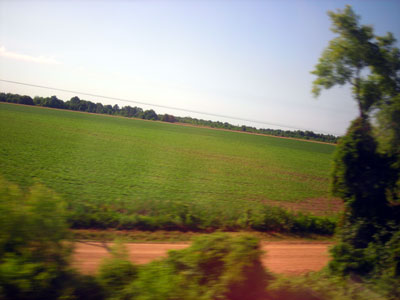
The endless fields go by. These were in Mississippi, I think.
Aboard the City of New Orleans
7 AM, June 26, 2008
Booking a coach seat on the Amtrak was a bit of a crapshoot, like the junior high game “Thirty Minutes of Heaven or Thirty Minutes of Hell, where you get in a closet with someone randomly chosen and have to endure until your friends let you out. Only this was going to be for a lot longer than thirty minutes. We're scheduled to arrive in New Orleans at 3:30 this afternoon, 16 hours after leaving St. Louis, and I'll have this evening and tomorrow morning to explore. Then, at noon tomorrow, I board the westbound train, the Sunset Limited, which doesn't roll into LA for 48 more hours!
So far it’s been almost entirely pleasant, from the moment my brother let me off in that ludicrously retro St. Louis station, and then in an hour, the van—not a bus, after all —took off for Carbondale, Illinois, to meet the train coming down from Chicago. The two hour van ride was easy because there were only three of us, one for each van-width seat. “Stretch on out,” the driver said. I sat up as we crossed the river, and watched the fields and towns and woods slide by for awhile after that, but then found myself tipping towards the horizontal. It was 11 o’clock at night when we set out, after all. I reclined on my big shoulder bag, most of the way.
The Carbondale station is a little better than the St. Louis one. It’s at least what you would expect in a town that size. And it was minus the junked cars and such things. We got in exactly at one, but the train wasn’t there, and it didn’t come.
"They're usually late," a man with a white goatee, standing near the door, said with a wizened smile. Bob was a veteran of the rails. He had a back pack, a friendly face, a gift of gab, and a lot of information about many subjects. He was the kind of man you'd call an “old-timer”—but an old-time what, he just wouldn’t tell me! He changed the subject with a merry laugh, every time I turned the topic of conversation the slightest bit toward him.
We stood there for nearly and hour. Bob seemed to have access to an unending flow of words. These tracks, which had once been owned by the Illinois Central line, had been bought by Canadian National, he told me. That was who had the right of way on the tracks.
Sometimes he said complimentary things about what he perceived, or said he perceived, to be my personal qualities: my capacity for listening, for instance. Bob said I really listened to others, and that was unusual. He said my face objectively displayed that quality, and intelligence, as well, that such things have been studied and mapped out—which, to some extent, I think I knew. "That's the latest thing in airport security, you know...to have a camera behind the ticket counter, analyzing the faces of customers to get a sense of their stability and mood."
When I heard that, I half-jokingly asked Bob if he's in some secret line of work, like maybe the CIA. Of course he laughed again and quickly changed the subject. Even the innocuous question, “Where are you heading after New Orleans?” drew the same response.
Bob and I talked most of an hour. The whole time a pretty young woman in a long, soft-yellow dress was standing outside by the station. She reminded me of a butterfly. A cloth bag and a beautiful, folded turquoise blanket lay on the sidewalk in front of her. She came in once for a little while, and in a brief conversation she introduced herself to us as Marlo. She visits New Orleans often, she said, and was taking the train for the adventure, just like me. Soon she went back outside for some fresh air.
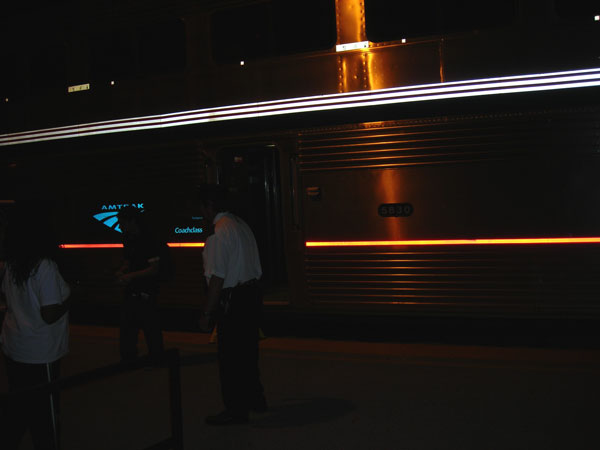
the City of New Orleans arrives in Carbondale, Illinois
Finally, after an hour and ten minutes, the train rolled in. The few railroad personnel at Carbondale sprang into action. A spotlight bathed everyone, and all the lights on the station platform went on. A uniformed railroad worker on the train handed down a yellow stool, the famous yellow stool Bob had told me about, that is used to boost passengers up onto the train, and we got on, one at a time.
I’d been told the train would be full, and it was a pleasant surprise to find people sprawled asleep across whole, two-seat rows, with many rows completely empty. I found a row toward the back of the car and got out the light blanket that at the last moment I’d thought to take, glad I’d brought it, because the car was cool. A friendly attendant came by bringing pillows. The train started up, and I was “ridin’ on the City of New Orleans”.
There wasn’t much to see at 2 AM, and so I started experimenting with sleeping positions. Not great, but not so bad, either. I concentrated on relaxing. I've heard relaxed resting is as restorative as sleeping, and I’m banking on that, because these pretzel positions really aren’t conducive to the soundest sleep.
But whether I slept or not, the “rhythm of the rails” brought a unique sensation of security, like being rocked in a cradle, some primordial cradle. That is, I’m sure, part of the archetypal allure of this form of travel, which hopefully will never die. From these few hours I'm already personally aware that it speaks profoundly, in ways that are in the final analysis inexplicable, to something deep in the human spirit.
I wore a sleeping mask most of the night. Peeking out, several hours into the trip, I saw the sky was already turning pink. We were passing through fields and woods, and here and there a forest or swamp. As the sun came up I just sat and watched the Earth roll by, an activity trains have a unique capacity to facilitate. Everything appeared mesmerizingly beautiful. It all reminded me of the big bag of wooden buildings and trees that my friend Bob had when we were small, that you could just spill out and then make your own world out of.
Sometimes I had the feeling of hiking deep in the woods, an explorer in my armchair seat. The train tracks convey more of a sense of privacy than most roads, since we’re not part of a stream of traffic. Indeed, the train runs through the middle of forests. it's easy to imagine that we’re the only ones who ever come here, that it's virgin territory. In fact, it is virgin territory, for these eyes.
Watching the panorama roll by, I thought, “This is perfect!”
Then came the inevitable next thought, “And it would be even better with a cup of coffee!”
I got up and walked down to the next car, passing an awake Bob and a sleeping Marlo, pushed the panel that opened the door to the club car next to us, and entered to find that a lot of other people had had the same idea! The line was dismayingly long. The system immediately seemed broken. There was no self-service, even for coffee. A single, heroic young man labored behind the counter to take, and then to fill, the order of passenger after passenger.
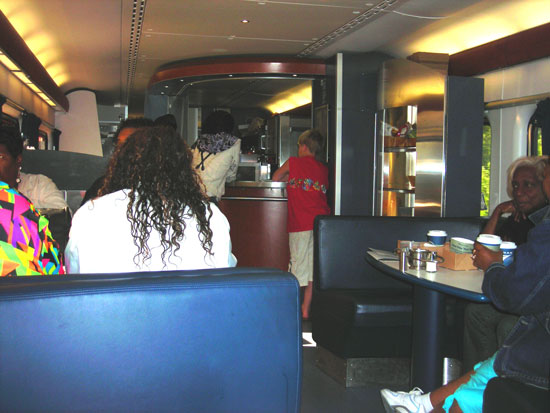 |
The snack car of the City of New Orleans at a moment when it wasn’t so crowded. Every few hours,
a man with a thick Creole accent made an announcement that he was taking reservations for the next meal in the “Cross Country Café”. Amtrak plays up its New Orleans cuisine on this route. I didn’t get to sample it, however. The shock of my first sight of the menu was enough to keep me limiting myself to snacks. By the time it wore off, we'd arrived in New Orleans. |
As I waited, I noticed that the man in front of me was holding a menu, and asked him if I might take a look. As I’d feared, the prices were astronomical. It was the captive market phenomenon, reminiscent of Rodney Dangerfield’s one-liner, “My wife asked me to take her someplace expensive to eat, so I took her to the airport!” They wanted $9 for an omelet! $7 for French toast! I was glad I’d brought a few Balance bars with me. The food prices were the one thing I hadn’t gotten around to researching.
Oatmeal was only $2, however. As it's part of my usual breakfast anyway, I had a bowl. It was quite good. The oatmeal and a cup of coffee came to $3.50. Back at my seat I devoured a Balance bar, and felt full.
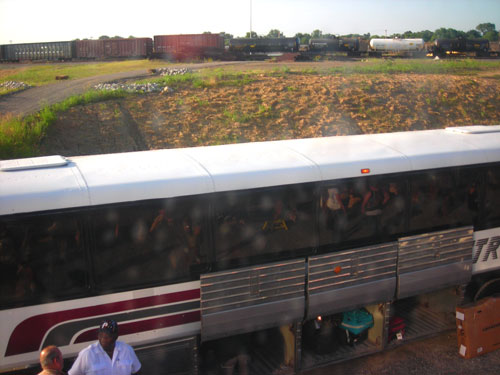 |
Above: The transfer bus on a gravel lot somewhere in Memphis, which currently serves as a station. Due to some kind of sinkhole, the Memphis staion's closed.
|
As I finished writing just now, the train pulled into Memphis…or rather, “Memphis”, since the Memphis Amtrak station is closed due to some kind of pipe burst, and they’re just loading people onto a bus here where we’ve stopped, at a nondescript train yard, and hauling them off somewhere. Weird. I’m a little tired, but so far, quite satisfied with Amtrak, on the whole. Soon we'll be in Mississippi, and I have hours and hours of gazing at the woods and fields and cities and bayous of the South ahead of me, and I feel quite content with that prospect.
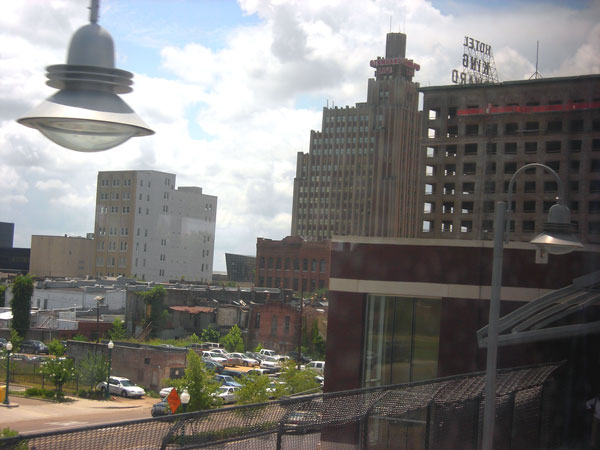
Jackson, Mississippi, where I tried, unsuccessfully, to reach my friend Peter by phone.
Just Before 2 pm
I suppose we’re a couple hours from New Orleans now. The train’s been going kind of slowly. We’re following a slow freight, they announced some time back, when we stopped for a little while. We’re running something more than an hour late, I think.
The ride has not fulfilled its spectacular, first-light promise. It’s comfortable and pleasant, but I’ve found the fields and woods a bit monotonous. I passed an hour or so listening to my library CDs of Obama's Dreams of My Father , but a lot of the time wound up just sitting here. The view is not fascinating enough to engross me completely, nor is it quite boring enough to let me stop looking and bury myself in some kind of work. (You never know what might appear.)
I stopped on my way up to the snack car and talked awhile with Marlo, who is a poised, lovely woman. Besides her turquoise blanket I'd also been struck last night by her simple jewelry, which also had a Native American feel. When I'd asked “What do you do?”, that awkwardly-worded question that means "Tell me a little about yourself", she'd alluded to having "several other interests" in addition to training at Southern Illinois University to become a school social worker. Now she mentioned that her main preoccupation the past two years has been fighting cancer. She’s been through two rounds of chemo and just finished a cycle of radiation. Yesterday she had a cat scan. She’s awaiting the result by phone. It may come at any moment. It will tell her whether all that radiation succeeded in shrinking the tumor, or not.
She’s a dear soul. Her father has been a loving support the whole time, and she has a devoted boy friend, as well. She’s only 27 years old. I felt the anxiety of her situation acutely and did my very best to be supportive. I feel I fell short; and yet, I did my best. Bless her.
The Rest of the Trip
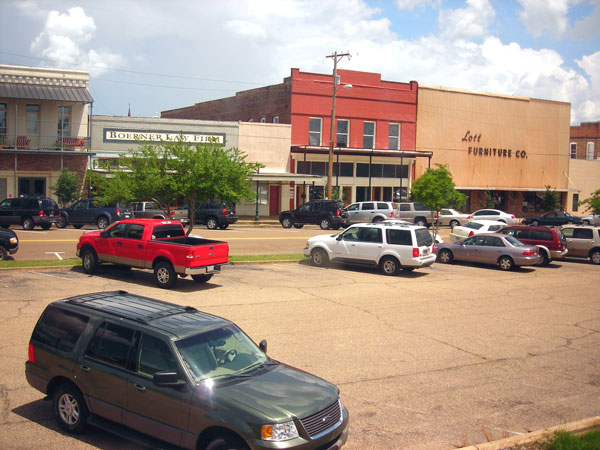
McComb, Mississippi, just before my camera broke.
We didn’t get into the New Orleans station until around 6. Our scheduled arrival time was 3:30. Not that I’m asking for a Mussolini, but it might be nice to have the trains run on time. My friend Bob explained to me that since the passenger trains are subsidized, whereas the freights are money-makers, freights get first priority. We did spend an hour or more waiting on freight trains; and then, toward the end of our run, we couldn’t get a drawbridge raised over an arm of Lake Pontchatrain. The conductor announced, in his truly mellifluous voice, that the drawbridge is controlled via computer nowadays by someone in the Chicago area, who could not be located. When he was located, he couldn’t open the bridge, for some reason, and a local inspector had to be called and go out on the bridge and re-set the circuits—or something like that. Amtrak seems a partly professional, partly amateurish or beaurocracy-infested operation. Having said that, let me give its up side a big nod: our coach attendant was a young lady whose warm, smiling welcome to the train last night immediately made this new rider feel right at home.
Another frustration I'm going through has nothing to do with Amtrak. Just as the Louisiana scenery was starting to be spectacular—we paralleled the bank of the massive Pontchartrain for miles, and when the lake was not visible, those last fifty miles or so, we traversed lush bayou country with Spanish moss-covered cypresses sunk to their knees in swamp water that was bright green with algae. Large white egrets were plentiful, and wild palms grew.
I reached into my pocket for my camera, to finally snap something besides sleepy southern downtowns; and I saw that I had accidentally turned it on, its lens cover had tried to open, it had gotten stuck, and the batteries were now way overheated and the “lens error” sign was on again. My “repair” method of turning the camera on and off many times brought no results. And so I sat, the last fifty miles or so of the trip, with a desire to document what I was seeing, to illustrate the story I’m telling here, that was simply not going to be satisfied.
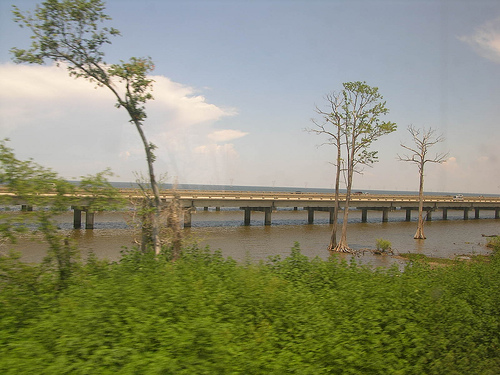
Lake Pontchartrain and causeway, leading into New Orleans (photo courtesy of Brandee Crisp)
After awhile we started passing suburban settlements of small, rundown houses, then industrial buildings of one sort or another. The density of such structures increased, and the skyline of New Orleans appeared in the distance. In another half an hour, we were in the station, which, unlike St. Louis’ little pillbox or Memphis’ gravel parking lot, is a real train station, with fine old WPA murals on the walls and several different tracks running right up to the station.
I was sitting beside Bob, listening to him talk about Andrew Jackson, while we were stopped alongside Lake Ponchartrain, when Marlo came walking down the aisle toward me.
“Max, I wanted to tell you, I got my call around a half hour ago. It was good news!” She smiled. The radiation treatments had eliminated the tumor. She was cancer free.
“Do you have a regimen for maintenance?” I asked.
“Nope,” she said. “Hopefully, it’s just over.”
I embraced her happily, and when we parted a little later in the station, I wished her a long, happy life.
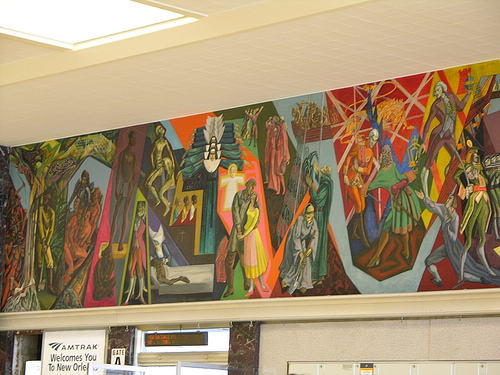
One of the murals in the New Orleans station (photo courtesy of Brandee Crisp)
on to Chapter Four: "New Orleans: Parts Seem 'Easy' Again"
back to Chapter Two
back to Chapter One
back to Contents
back to Title
|







